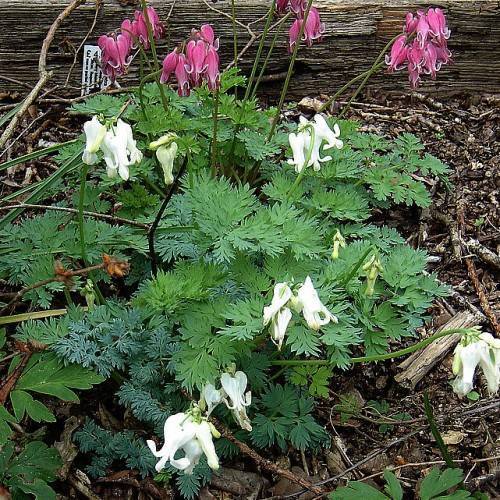
bleeding heart
Dicentra 'Ivory Hearts'
Cycle:
Herbaceous Perennial
Watering:
Average
Hardiness Zone:
3 - 8
Flowers:
Flowers
Sun:
Part shade,full shade
Leaf:
Yes
Growth Rate:
Low
Maintenance:
Low
Care Level:
Medium
watering
Bleeding Heart (Dicentra ‘Ivory Hearts’) plants should be watered on a regular basis in proper amounts. Aim to water the soil evenly, allowing it to become evenly moist but not soggy. During the spring and summer months, water the soil deeply at least once a week, providing 1-1.5 inches of water at each irrigation. During the fall make sure to water deeply at least once every 2 weeks. In the winter, reduce watering to about once every month, or as soil begins to dry. Always check soil moisture and adjust watering accordingly.
sunlight
Bleeding heart (Dicentra 'Ivory Hearts') requires bright indirect sunlight for the best growth. Partial shade and up to 4 hours of direct morning sunlight per day is ideal, which should be reduced in the afternoon. It is important to avoid placing this plant in an area of intense midday sun, as it can scorch the delicate foliage.
pruning
Bleeding heart (Dicentra 'Ivory Hearts') should be pruned once a year, in spring when new leaves are just beginning to appear on the plant. Prune the plant lightly, cutting away any dead or diseased stems and thinning out any overcrowded sections to ensure good air flow. Pruning will encourage good, vigorous new growth and help control the natural shape and size of your plant. Remove faded flowers as soon as they are noticeable. Trim the foliage back to the soil line after all bloom has finished.
Season
Hardiness Map
FAQ
How long does a bleeding heart plant live?
The Bleeding Heart plant is an attractive perennial flowering species with long-lasting displays of attractive flowers. It typically lives for between 2 and 5 years, but may live longer if given the right soil, sunlight, and water conditions. This is considered to be a relatively short lifespan in comparison to some other plants, but this can change depending on the individual plant and its environment.
Could bleeding heart grow in a hanging basket?
Yes, bleeding heart can grow in a hanging basket. The plant is a perennial and has graceful arching stems full of dangling blooms. It has small, heart shaped pink or white flowers that put on a show of color against the light green foliage and stems. When planting in a hanging basket, ensure the basket is large enough to provide the necessary root space and ample drainage. Only use a lightweight soil and make sure that it doesn't stay too wet.Bleeding heart is a beautiful choice for hanging baskets and requires very little maintenance.
Do bleeding heart flowers bloom all summer?
No, bleeding heart flowers typically do not bloom all summer. They tend to flower in late spring and then again in late summer or early fall, providing two distinct periods of blooming throughout the season. The flowers go into dormancy in the warmer months when temperatures are too high for them to flourish. During this resting phase, the plant will enter a period of dormancy where foliage will die back and the plant's energy reserves will be renewed.
Are bleeding heart flowers fragrant?
Bleeding Heart flowers are a popular garden variety native to North America and Europe, and although they are most noted for their unique heart-shaped flowers, they are not particularly known for their fragrance. These flowers produce a light, but barely noticeable fruity scent that is mostly lost on the human nose. If you are searching for fragrant flowers, consider buds with a stronger scent such as roses, lilac, and lilies.
Is bleeding heart a good plant for a cutting garden?
Yes, the Bleeding Heart plant is an excellent addition to a cutting garden. It produces tooth-shaped pink and white flowers that hang from a thin stem, making them perfect for cutting. The plant is also long-lasting in the garden and it can produce new blooms for up to four months during the warmer months. It grows easily in partial or full shade and requires little maintenance. Additionally, it can also be used to attract butterflies and hummingbirds to the garden.
Should I mulch around my bleeding heart plant?
Yes, it's a good idea to mulch around your bleeding heart plant. Mulch helps preserve soil moisture and keeps weeds away. It also helps to control soil temperature and improve soil structure, which can help your plant stay healthy and thrive. Be sure to use an organic mulch, such as bark chips or shredded leaves, and keep it a few inches away from the stems and foliage of the plant. You can also spread it in a circular pattern around the plant for a decorative look.
Could a bleeding heart grow in a greenhouse?
Yes, a bleeding heart can grow in a greenhouse. It is a perennial flowering plant that thrives in partial to full shade and average to moist soil conditions. Maintaining a stable temperature between 50-60F and adequate humidity can be a challenge in a greenhouse, but it can easily be achieved with proper ventilation and insulation. The potting mix should be well drained, yet holds moisture well so that the plant can get the necessary nutrients. A weekly dose of balanced fertilizer is recommended to keep the plant healthy and flowering throughout the season.
How many blooms can a bleeding heart plant produce in a season?
A bleeding heart plant can produce a plentiful amount of beautiful blooms throughout its bloom season, which typically runs from early spring to late summer in most areas. The number of blooms per plant can vary greatly, ranging from only a few to a massive amount, depending on the care and attention the plant receives. With the right conditions and adequate care, a single bleeding heart plant can produce over 50 blooms in a single season!
